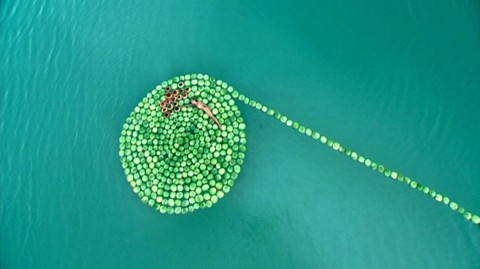Israeli artist Sigalit Landau was born in 1969 and raised in Jerusalem. She currently lives and works in Tel Aviv. She received a B.F.A. from Bezalel Academy of Art and Design in 1994 and spent a semester at The Cooper Union in New York City where she was a student of Hans Haacke. Her work has been in numerous international solo and group exhibitions at venues that include the Venice Biennial; the Museo Reina Sofia, Madrid; the Ballroom Marfa, Texas, and The Museum of Modern Art, New York.
Landau works in a variety of media, from performance and video to sculpture and installations, in which she physically and conceptually transforms her materials. She frequently employs salt, sugar, water, foods, and barbed wire to enact rituals of endurance and create visions of subversive beauty that allude to torture and violence. Although the turmoil of her homeland plays a significant role in Landau's artistic practice, the themes of her work transcend specific events to reflect upon the issue of borders in a universal sense. She utilizes materials that function as symbolic bridges connecting past to future, west to east, private to collective, and center to periphery. Her art also highlights the shifting definitions and interdependence of those concepts. Thus, Landau questions allegiances and the societal and individual limitations that they impose.
In her attempt to transcend a wide range of boundaries, Landau employs both natural dividing lines, such as bodies of water, and those that are constructed, like houses and hoops. _Barbed Hula_ (2000), for instance, is a two-minute video shot on a Mediterranean beach that captures Landau whirling a hula hoop made of barbed wire around her nude body. The camera closes in on her torso and its bloodied wounds, emphasizing Landau's grisly slant on a usually playful act. Likewise, her series of installations in _The Dining Hall_ (2007) include a depiction of the demise of a once Utopian kibbutz community. In a horrific scene, life-size papier-maché figures resembling exposed muscle tissue engage in gluttonous and violent acts. The work suggests that eating is a form of border-crossing that can also be an act of survival or one of excess and privilege.
Landau also offers a dialectical perspective on food in _DeadSee_ (2005), which begins with an overhead view of a crowd of watermelons floating in the Dead Sea. The circular movement of the camera slowly reveals Landau's nude body nestled, or perhaps trapped, within the group with her right side submerged in the saltwater. Her right arm reaches toward several sliced melons whose exposed redness resembles bloodied gashes and wounded flesh. The camera then pans out to reveal a spectacular spiral of five hundred watermelons linked together with a cord. Despite the heavy stillness of the Dead Sea, Landau's raft uncoils clockwise, as if in a slow whirlpool, and is steadily pulled off the right side of the frame. As the spiral unfurls, Landau clutches the wounded fruit and follows them off-screen.
While the blue of the sea and the greens and reds of the watermelons create an aesthetically beautiful tableau, the imagery also imparts a sense of suffering and brutality. As is typical of Landau's practice, _DeadSee_ reveals contrasting sensations. The serene, organic appearance of the float contrasts with the lifelessness of the Dead Sea, the salinity of which would have distressed Landau's body, especially her submerged right eye, for the duration of the performance. Moreover, _DeadSee_ poetically conjures associations from its geographic context amidst Israel, Jordan, and the West Bank. This implies specific yet universal tensions: the violence that occurs within, across, and because of borders, as well as the physical and mental barriers that affect the politics of race, religion, and the environment. _—Kanitra Fletcher_

